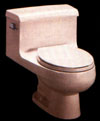M5. Install Water-Saving Toilets
Description
 In some areas, water and sewer rates have increased dramatically over the past few years and are rivaling the cost of energy. Reducing water use through conservation strategies can generate significant cost savings. Significant advances in technology over the past decade have resulted in the availability of reliable, high-quality water-saving toilets on the market.
In some areas, water and sewer rates have increased dramatically over the past few years and are rivaling the cost of energy. Reducing water use through conservation strategies can generate significant cost savings. Significant advances in technology over the past decade have resulted in the availability of reliable, high-quality water-saving toilets on the market.
Some water providers offer rebates and incentives for replacing inefficient toilets. Contact your provider to see if there is a program available.
Applicability
- Single-family and multifamily buildings that do not have water-saving toilets
Considerations
- High-quality toilets should be selected.
- Because water-saving toilets will clog if misused, this measure should be accompanied by resident education to prevent unacceptable items from being placed in the toilet.
- Water-saving toilets may not operate properly in buildings with very old sewer lines.
Performance/Economics
- Toilets account for 25 to 50 percent of total household water consumption. Older toilets use anywhere from 4 to 10 gallons per flush.
- New models use 1.6 gallons or less per flush, cutting the water use by 60 to 80 percent.
Resources/Links
Energy Conservation for Housing – A Workbook, HUD, September 1998. Pages 7-149 and 7-150 address installing water-saving toilets.
How to Buy a Water-Saving Replacement Toilet. Provides useful tips on purchasing and installing a water-saving toilet, including information on cost-effectiveness.
PATH Technology Inventory: Low-Flow Plumbing Fixtures. Explains faucet aerators, low-flow showerheads, and low-flush toilets, including types, installation, benefits, costs, and limitations.
Energy Cost Calculator for Toilets. Helps calculate savings from installing water-efficient toilets.
Water-Efficient Fixtures & Appliances. Provides an overview of these types of fixtures, GPM considerations, as well as additional links for additional information.
|
TURN OFF UTILITIES: Turn off electricity, gas, propane, and other utilities before starting repairs, cleaning, or installations to avoid accident or injury. BE AWARE OF LEAD-BASED PAINT HAZARDS: Many residences built before 1978 have paint that contains lead, which can pose a serious health hazard if paint, chips, and dust are not handled properly. See the U.S. Environmental Protection Agency (EPA) lead brief before disturbing painted surfaces in homes of this vintage. Follow the HUD "Lead-Safe Housing Rule" for requirements for notification, evaluation and reduction of lead-based paint hazards. BE AWARE OF ASBESTOS HAZARDS: Homes older than 1977 may have building products that contain asbestos such as insulation, high-temperature gaskets, roofing and siding shingles, and vinyl sheet flooring. See the EPA asbestos brief before disturbing such materials. BE AWARE OF MOLD AND MOISTURE HAZARDS: Molds can gradually destroy materials they grow on; can irritate the eyes, skin, nose, throat, and lungs of both mold-allergic and non-allergic people; can cause asthma attacks in people with asthma who are allergic to mold; and can cause other serious health problems. To learn more about preventing and cleaning up mold in homes, see these mold guides and the EPA brief on What to Wear When Cleaning Moldy Areas. |